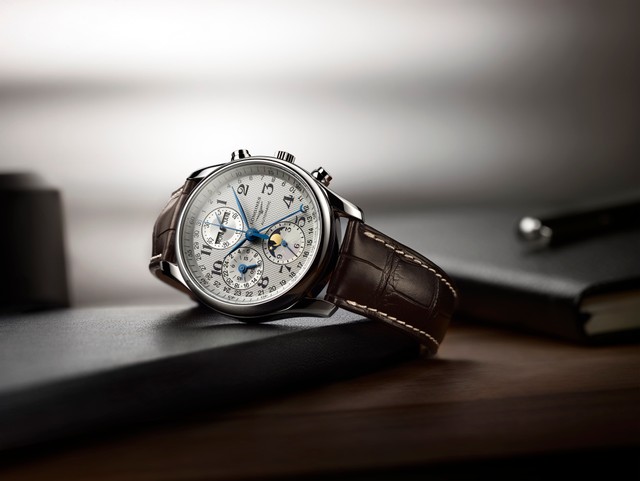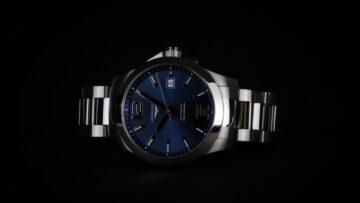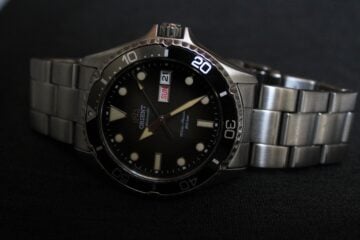Humans have always relied on the movements of the sun and moon to keep track of passing time. The phases of the moon correlate to the days of the month passing and have been used through millennia for timekeeping. The fascination with the moon appears in childhood storytelling, fashion and décor. It extends far beyond its original purpose of measuring time. As humanity has relied on the moon less for this purpose, the wonder that surrounds it has not waned. The history of the moonphase complication shows how humanity is still enamoured by the movements of the moon and although it is no longer a necessity, enjoys being able to track its movements within a timepiece.
What is the Moonphase Complication?
The moonphase complication is an aperture in the dial of the watch that depicts the moon’s phases. It relays the 29.5 day lunar cycle by showing the current moonphase. It is often included on elegant dress watches as a point of interest on an otherwise simple dial. It is a detail that watchmakers are keen to feature in their work as it exhibits very high-quality craftsmanship using the Romantic image of the moon. Although the moonphase complication may look like a purely artistic feature, a lot of calculation and expertise is required to create one.
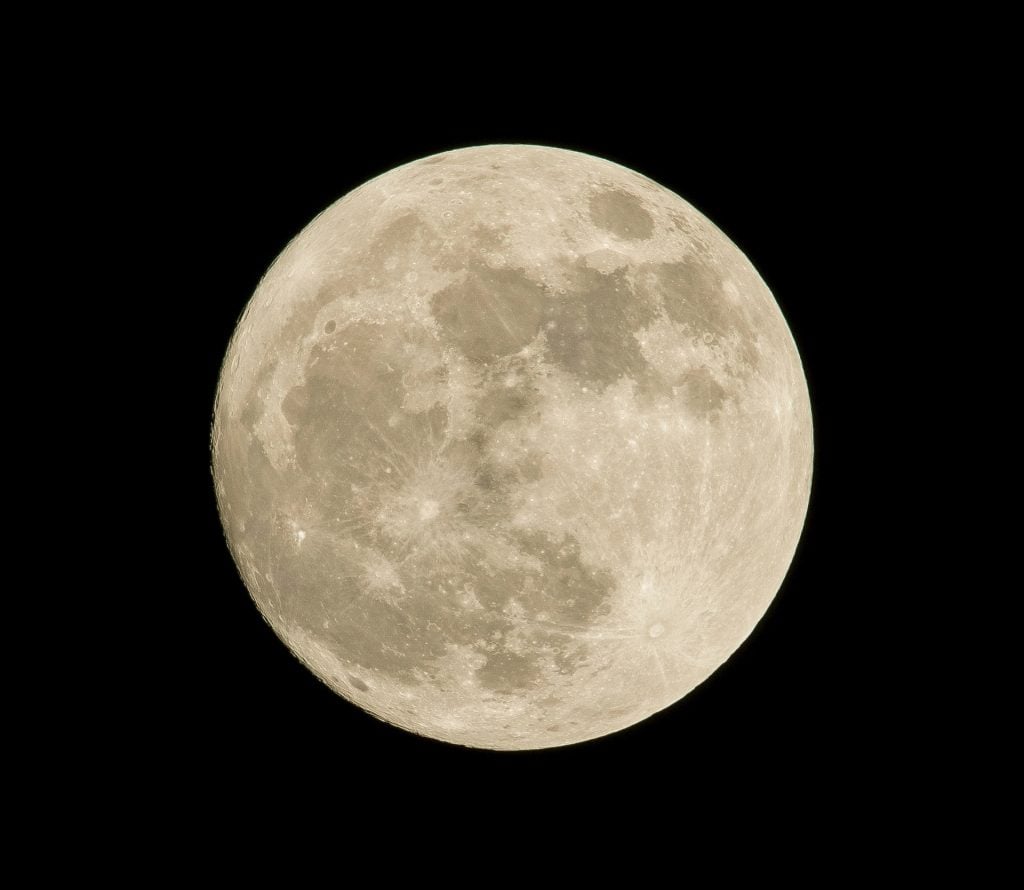
The moonphase complication works by taking energy from the centre wheel of the movement, which rotates once an hour. This energy drives another wheel at a ratio of 1:2, which takes it from a complete rotation of 12 hours to a full 24 hours. This wheel features a finger that drives the moon disc. It advances the disc by one increment every day. This creates the illusion of the moon moving across the sky. Most lunar watches contain a gear with 59 teeth. This is two lots of 29.5, which correlates to the 29.5 day long lunar cycle. Unfortunately, as the lunar cycle is of such a peculiar length, a moonphase complication will normally fall out of time after around three years. As a result of this, higher quality moonphase watches often use smaller increments to increase the accuracy of the complication.
What is the Origin of the Moonphase Complication?
The history of the moonphase complication dates back to Ancient Greece. The earliest example of a moonphase movement is the Antikythera Mechanism that was built by the Ancient Greeks. It is thought to have been developed to predict astronomical events. It displayed moon phases and could predict eclipses. The complexity of the Antikythera remained unmatched for 2000 years.
Following the Ancient Greeks, the next examples of moonphase movements were built into churches and cathedrals during the Renaissance period. These clocks depicted Earth at the centre, with the other planets, moon and sun orbiting around it. The popularity of these astronomical clocks dwindled when scientists, like Galileo, discovered that the Earth was not the centre of the universe.
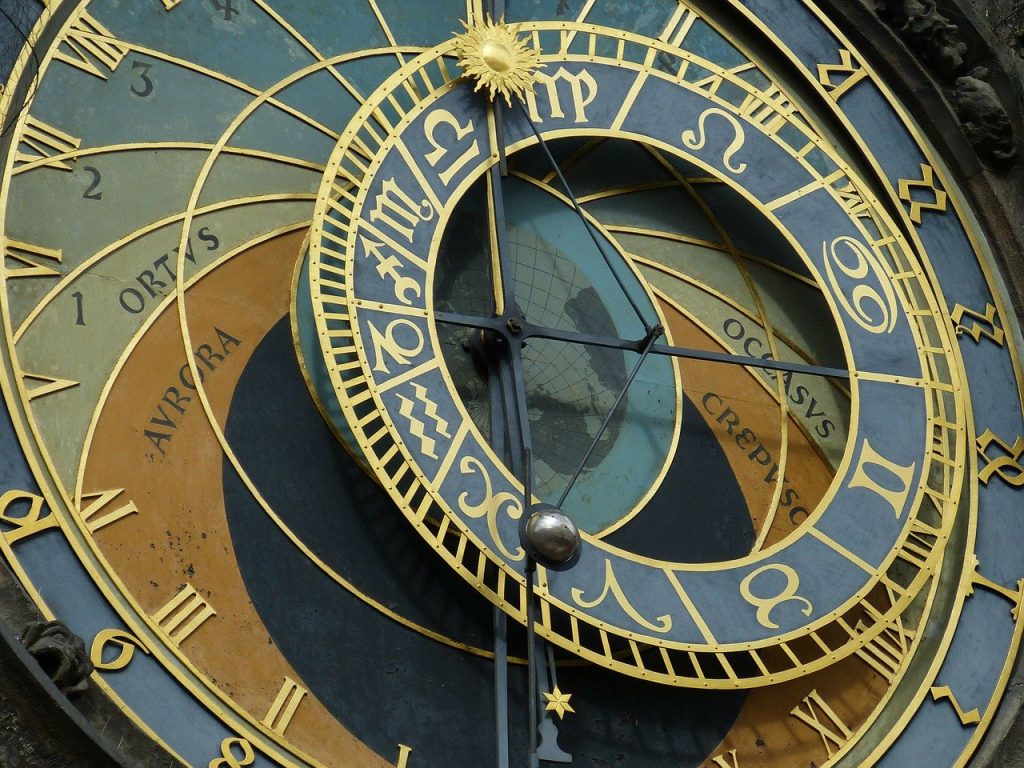
It was not until the 16th Century that moonphase complications began to appear in standalone clocks. Generally, only complex English and German grandfather clocks that featured a moonphase complication. It would have been very desirable to have a beautiful moonphase grandfather clock as the centrepiece of the home.
The moonphase complication began to feature in wristwatches during the 20th Century. The complication was a key feature in the development of the perpetual calendar complication. Although it is not commonly relied upon for timekeeping, it does make an eye-catching design and it is a sentimental reflection of humanity’s timekeeping history. Throughout the decades, the design of the moon in these complications has changed. In early designs, it was often given a face to create a ‘man-in-the-moon’ figure. Later, it was shown as a solid circle to stay on trend with the Art Deco period. With the development of modern technology, many watchmakers have strived to make their miniature moons as realistic as possible. The moon can be engraved to give the appearance of craters for a detailed, life-like finish.
The Types of Moonphase Complications.
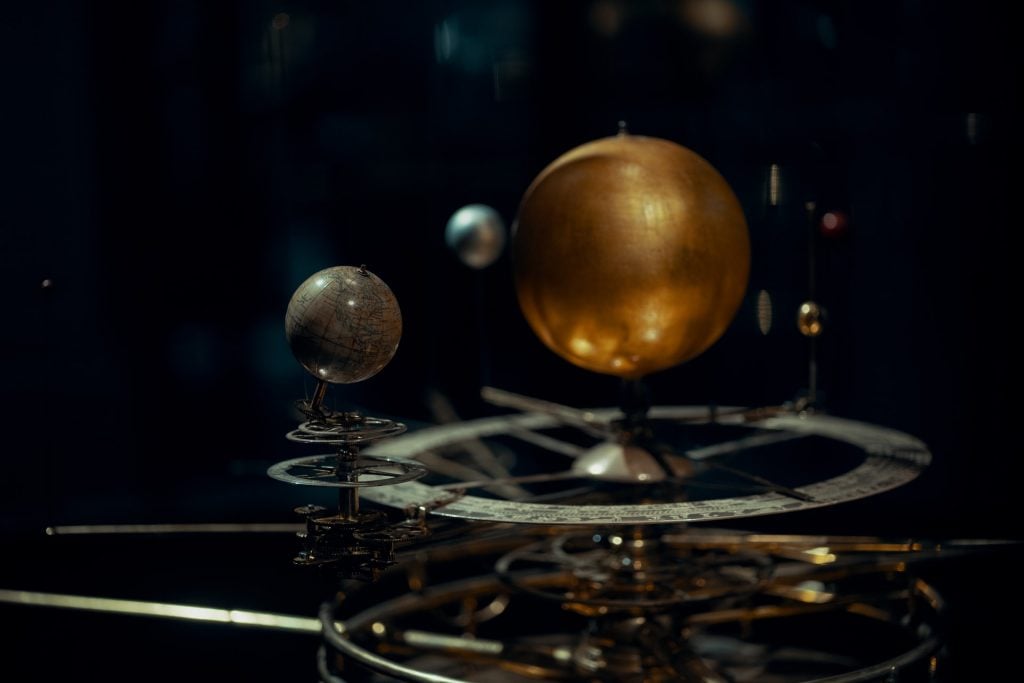
There are two main types of moonphase complications. The simplest is the radial moonphase complication. This uses an indicator hand to track the moon phase on a dial. The more complex type complication is the bosom moonphase complication. This type takes a graphical approach by physically showing the moon move through its various phases using a crescent shaped aperture.
A bosom moonphase complication tends to be favoured by watchmakers as they are an eye-catching focal point on a dial. The moonphase complication is one of watchmaking’s least understood complications, making it one of the most desirable. These complications are often found in high-end watches due to the quality craftsmanship required to build this movement. Humanity continues to be fascinated by the moon’s movements and the desire to feature it in modern timepieces is still very present.
5 Luxury Moonphase Watch Recommendations.
If you are interested in adding a moonphase watch to your collection, keep reading for some of our recommendations.
Longines Master Collection 42mm Men’s Swiss Automatic L27734783
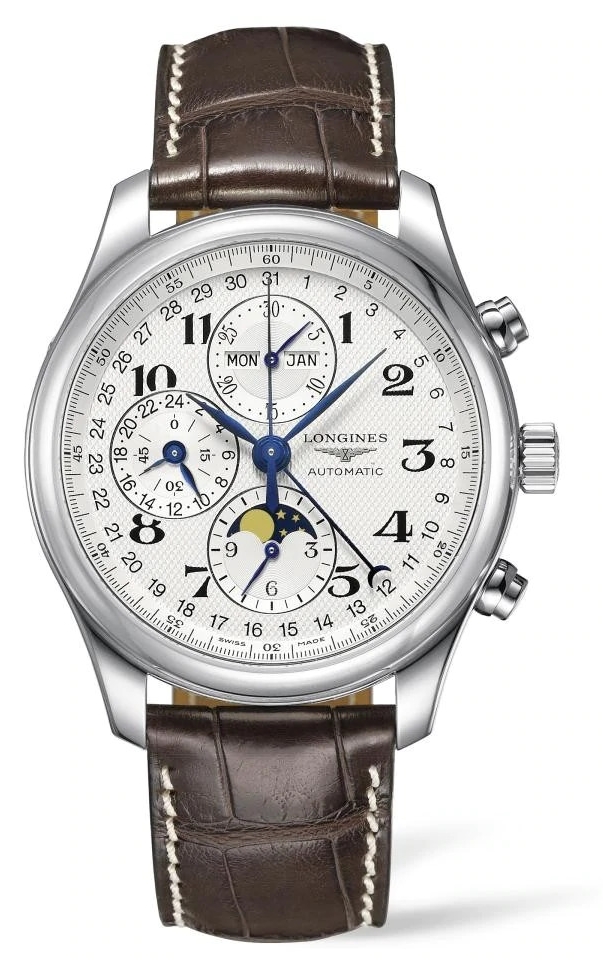
This watch was launched as part of the Longines Master Collection in 2005 and is designed for the collector who values the watchmaking expertise required to make a timepiece of this quality. This model has a classic, luxurious look which is accentuated by the white top-stitched, brown alligator leather strap. The white dial makes a clean backdrop for the three sub dials, one showing the day and date, the second exhibiting a 24-hour clock, and the third featuring a bosom moonphase complication. The moonphase complication on this watch shows a yellow moon moving across a blue sky, providing a hint of colour to the otherwise black and white dial. The blue sky is complemented by the blue hands of the watch. With an automatic movement of the Calibre L687 that is visible through the skeleton case back, this watch is stylish and functional. The dial and case back both use scratch resistant sapphire glass, so the watch will continue to look brand-new for years to come. This moonphase watch is a tribute to Longines’ long history of impeccable watchmaking. It would make an excellent addition to any watch collection due to its classic look with the added flair of a moonphase complication.
Frederique Constant Mens Classics Moonphase Heart Beat Automatic FC-335MC4P5
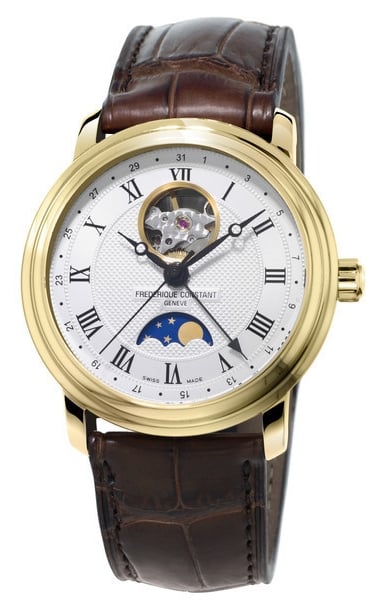
Frederique Constant places a lot of focus on the visual appearance of their watches, whilst also ensuring to create a high-quality movement. This watch features a white dial with Clous de Paris detailing. The pale dial creates a contrasting backdrop for the bosom moonphase complication to stand out as the focus of attention. The moonphase shows a yellow moon and stars moving in a blue sky. The dial is balanced by a skeleton aperture at the top of the dial, showcasing the intricate automatic movement of the calibre FC-335. The dial also features a date dial around the very edge for optimal timekeeping. The gold-plated stainless-steel case and brown leather strap give this watch a traditional and timeless look. The clean dial makes for easy readability, but Frederique Constant have addressed every need and desire on this watch by featuring numerous extra features. This model is water-resistant to 6 bar, so it is practical for everyday wear.
Baume & Mercier Women’s Classima Blue Leather Silver Moonphase Dial M0A10329
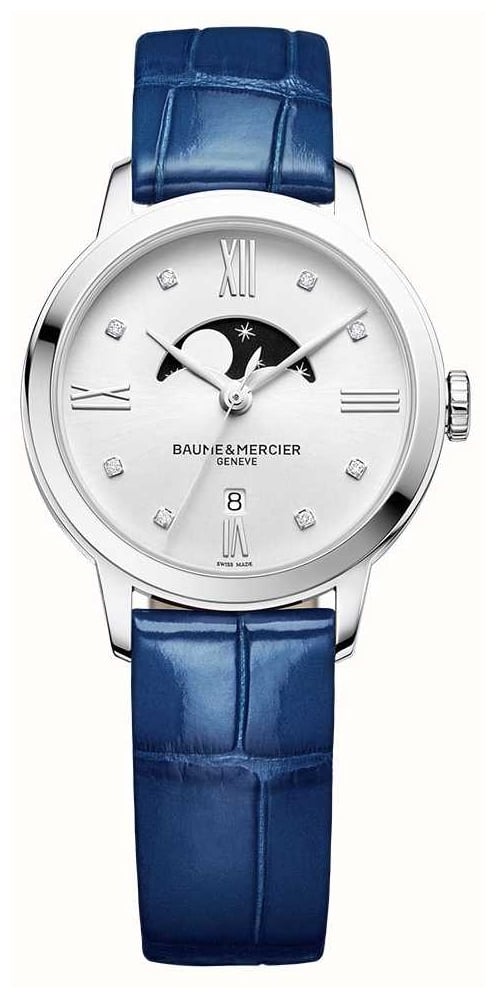
This watch is designed with women in mind, so it features a smaller dial to sit comfortably on a lady’s wrist. The watch has a clean and classic silhouette, ensuring that all of the focus is placed on the central bosom moonphase complication. The white dial features silver Roman numeral and diamond indices and is framed by the 31mm stainless-steel case. The pale colour palette is juxtaposed by the blue leather strap. The dark moonphase aperture is the centre of attention in this timepiece due to the contrast it creates with the dial. The appearance of the white moon in the black sky is striking and creates an eye-catching feature of the watch. The dial features a small date aperture at the 6 o’clock point, but it does not distract from the otherwise simple dial. The clean elegance of the watch makes it suitable for all occasions and events. The simple colour palette and central moonphase complication would make it a wonderful addition to any lady’s watch collection.
Longines The Longines 1832 Men’s Swiss Automatic L48264520
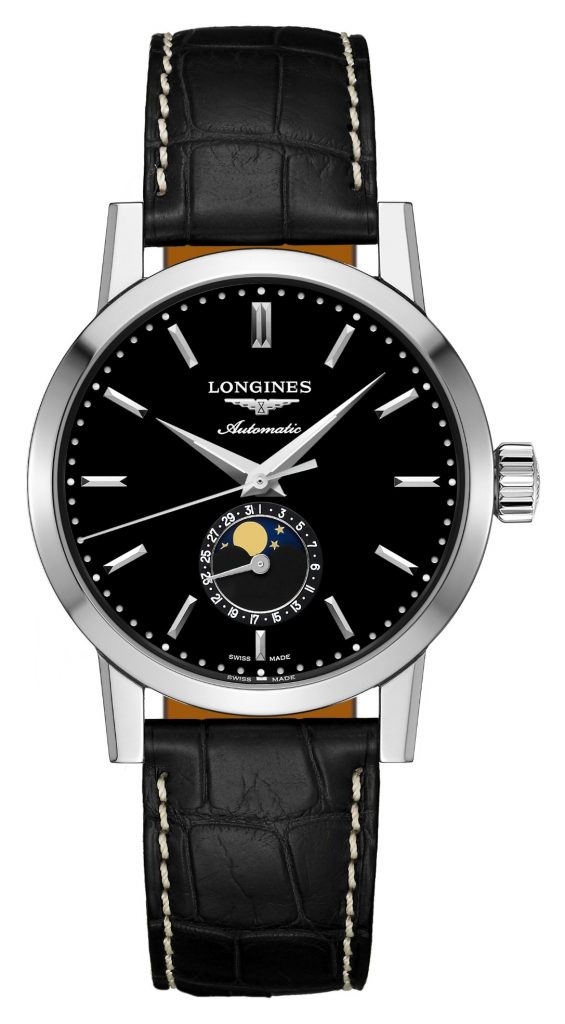
The moonphase complication is the only touch of colour in this watch. The timepiece is attention grabbing due to the black and silver colour scheme. The black dial features silver hands and stick indices for a clean finish. A 40mm stainless-steel case frames the dial, creating a pleasant contrast to the dark colour. The moonphase complication is found in the bottom half of the dial. It exhibits a simple, yellow moon and stars in a blue sky. The complication is surrounded by a very subtle date dial to ensure optimal timekeeping.
This watch has a high-quality interior in the form of the automatic calibre L899 movement. The alligator effect, black leather strap with white topstitching completes the sleek appearance of this watch. This timepiece proves that moonphase watches do not have to be especially complex. A simple and chic finish is still achieved whilst paying homage to the history of the moonphase complication and how humanity first told time.
Maurice Lacroix FIABA Moonphase 18ct PVD Plated FA1084-PVP13-150-1
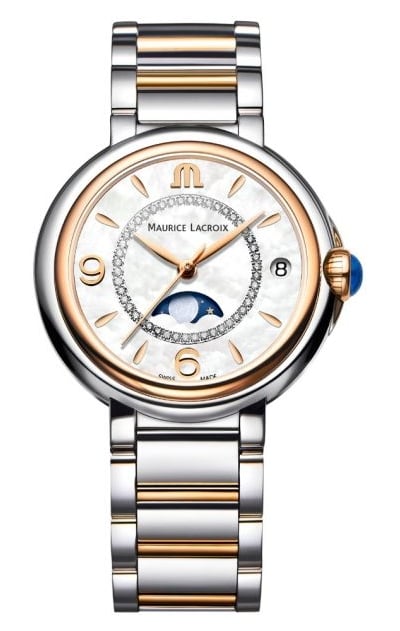
This luxury model from Maurice Lacroix features a moonphase function, a ring of diamonds, and a rose gold and silver colour scheme. The white dial is framed by a rose gold-plated stainless-steel two-tone case. The mixed metal finish gives a modern and luxurious feel to this timepiece and ensures it will match other jewellery worn with it. The dial features a small date aperture at the 3 o’clock point. The bosom moonphase complication is in the bottom half of the dial and exhibits a white moon and stars moving through a blue sky. The blue of the complication is complimented by the blue-topped crown, creating a cohesive look. These elements of colour provide a point of interest to an otherwise traditional watch. This model is powered by a quartz movement so the wearer can depend on it to be accurate. The ring of diamonds that surround the centre of the watch add an additional touch of luxury to this high-end timepiece. The case of the watch measures 32mm and is finished with a rose gold PVD stainless steel two-tone strap. The watch fastens with a butterfly buckle. This element of security means that the watch can be added to any outfit for a flair of style and luxury without the fear of it being lost. This moonphase watch is ideal for those who wish to add an element of glamour and elegance to their watch collection.
What did you think about our history of the moonphase complication? Would you consider adding a moonphase watch your collection? Let us know in the comments below!

